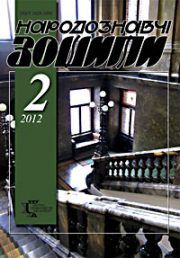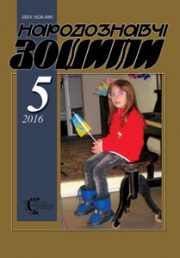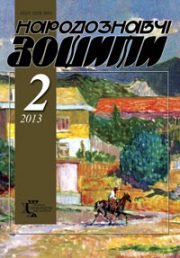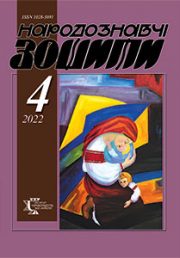The Ethnology Notebooks. 2022. № 5 (167), 1080—1091
UDK [[39:728.6]:643.3](477.87=511.14)
DOI https://doi.org/10.15407/nz2022.05.1080
THE KITCHEN AND STOVE OF A TRADITIONAL TRANSCARPATHIAN HUNGARIAN PEASANT HOUSE
KESZ Barnabas
- ORCID ID: https://orcid.org/0000-0002-8417-8441
- PhD, Associate Professor, Department of History and Social Sciences
- at the Ferenc Rakуczi II Transcarpathian
- Hungarian College of Higher Education,
- 6, Kossuthsquare, 90202 Berehove, Ukraine,
- Contacts: e-mail: kesz.barnabas@kmf.org.ua
KESZ Margit
- ORCID ID: https://orcid.org/0000-0001-9738-2858
- PhD, Associate Professor, Department of Philology at the
- Ferenc Rakуczi II Transcarpathian
- Hungarian College of Higher Education,
- 6, Kossuthsquare, 90202 Berehove, Ukraine,
- Contacts: e-mail: kesz.margit@kmf.org.ua
Abstract. The study of traditional folk architecture is one of the popular areas in ethnography. This task is especially relevant in regions that ethnographers consider to be relatively white spots, such as the multiethnic Transcarpathia, which has historically belonged to several state formations. Ukrainians, Hungarians, Romanians, Slovaks, Germans and other ethnic groups who have lived here in friendship for centuries mutually enrich each other’s culture, creating unique examples of interethnic relations. In this paper, the authors made an attempt to document the traditional housing culture of the Hungarian rural population of Transcarpathia. The object of research is folk architecture, and the specific subject of the research is the kitchen, which together with the oven and equipment forms the central and main room of the Hungarian peasant house in Transcarpathia. The aim of this study was to determine the type of traditional Transcarpathian Hungarian house and kitchen, as well as to outline the history of culinary space and its heating equipment, which play a central role in a family’s life, their local features, parallels or differences with other regions and peoples. Based on our main hypothesis, we suggested that in more remote villages of the region traces of archaic elements known in the material culture of different peoples and ethnic groups living at the confluence of the Great Alfцld and Carpathians can still be found (open veranda, open chimney, fireplace, stove, etc.). In addition to the principle of historicism, the methodological basis of the study includes proven methods of ethnography, such as elements of retrospective, typological, comprehensive analysis or, for example, historical reconstruction. Territorially, the study covers Hungarian and mixed villages in the southwestern part of Transcarpathia, the historical Ugocha County, and chronologically — the first half of the XX century, with some references to changes that took place in the second half of the XX century. In addition to the study of archival material and ethnographic literature, the source material of the study was the latest research, field analysis of the authors, photos and other documents, in-depth interviews with informants.
Keywords: Hungarians of Transcarpathia, three-part house,entryway, kitchen, free chimney, stove, fireplace, tripod, wood holder.
Received 5.09.2022
REFERENCES
- Fedaka, P.M. (2005). Folk dwellings of Ukrainians of Transcarpathia in the 18th—19th centuries. Uzhhorod: Hrazhda [in Ukrainian].
- Kesz, B., Gazda, V., Karmacsi, Z., & Toth, E. (Eds.). (2016). The Ugocha peasant house. Traditional architecture is Salank. In: Gazda, V., Karmacsi, Z., Toth, E. Values and challenges. Materials of the lectures given at the conference «Linguistic and cultural diversity in East-Central Europe: value and challenges», March 26—28, 2015, Beregszasz, II volume (History and social science, educational methodology, literary science) (Pp. 63—73).Uzhhorod: Autdor; Shark [in Hungarian].
- Dragun, I.V., Cseri, M., & Viga, Gy. (Eds.). (1989). Peculiarities of the folk architecture of Hungarians living in Transcarpathia. In: Cseri, M., Balassa, M.I., Viga, Gy. Folk construction in the northeastern region of the Carpathian Basin (Proceedings of the conference held in Miskolc on May 15—16, 1989) (Pp. 165—180). Miskolc; Szentendre: Szentendre Open Air Ethnographic Museum; Miskolc Herman Otto Museum [in Hungarian].
- Balassa, M.I., Cseri, M., & Viga, Gy. (Eds.). (1989). On the development of residential buildings in the northeastern region of the Carpathian Basin. In: Cseri, M., Balassa, M.I., Viga, Gy. Folk construction in the northeastern region of the Carpathian Basin (Proceedings of the conference held in Miskolc on May 15—16, 1989) (Pp. 63—84). Miskolc; Szentendre: Szentendre Open Air Ethnographic Museu; Miskolc Herman Otto Museum [in Hungarian].
- Dam, L., Cseri, M., Balassa, M.I., & Viga, Gy. (Eds.). (1989). Architectural regions in the northeastern region of the Carpathian Basin. In: Cseri, M., Balassa, M.I., Viga, Gy. Folk construction in the northeastern region of the Carpathian Basin (Proceedings of the conference held in Miskolc on May 15—16, 1989) (Pp. 93—107). Miskolc; Szentendre: Szentendre Open Air Ethnographic Museum; Miskolc Herman Otto Museum [in Hungarian].
- Gilyen, N., & Kecskes, P. (Ed.). (1989). The house with open eaves in the Upper Tisza region. In: Kecskes, P. House and man, papers of the Open-Air Museum of Ethnography, 5th Szentendre Open-Air Museum of Ethnography (Pp. 51—56) [in Hungarian].
- GrozdovaI, N. (1972). Ethnic Specificity of the Hungarians of Transcarpathia. Carpathian collection (Pp. 95—107). Moscow: Nauka [in Russian].
- Grozdova, I.N., & Kovalskaya, N.G. (1979). Dwellings of the Hungarians of Transcarpathia. Material culture of complete ethnic groups in Ukraine (Pp. 151—181). Moscow: Nauka [in Russian].
- Grozdova, I.N., & Ortutay, Gy. (Ed.). (1971). Ethnocultural processes among the Transcarpathian Hungarian population nowadays. In: Ortutay Gy. Folk culture — folksociety (Pp. 457—466). V—VI Yearbook of the Ethnographic Research Institute of the Hungarian Academy of Sciences. Budapest: Academy publishing house [in Hungarian].
- Filep, А. (1976). Historical types of the Hungarian folk dwelling and its interethnic relations in the Carpathians. Carpathian Collection (Pp. 35—39). Moscow: Nauka [in Russian].
- Szabo, S., & Ratko, L. (Ed.). (2014). Hpusehol items. In: Ratko, L. Folk art of Szabolcs-Szatmar-Bereg county (Pp. 420—451). Nyiregyhaza: Josa Andras Museum [in Hungarian].
- Barabas, J., & Gilyen, N. (2004). Hungarian Folk architecture. Budapest: Mezogazda kiado [in Hungarian].
- Deak, G., & S.Benedek, A. (Ed.). (1998). Folk Architecture and Art in Ung County’s Tiszahбt. In: S.Benedek, A. Ung county. Papers on Ung County (Pp. 81—89).Beregszasz; Budapest: Mandatum Kiado; Hatodik Sip Alapitvany [in Hungarian].
- Pall, I., Cseri, M., Balassa, M.I., & Viga, Gy. (Eds.). (1989). The mixing of landscape features in the folk construction of Northeast Hungary in the 18th and 19th centuries. In: Cseri, M., Balassa, M.I., Viga, Gy. Folk construction in the northeastern region of the Carpathian Basin (Proceedings of the conference held in Miskolc on May 15—16, 1989) (Pp. 197—208). Miskolc; Szentendre: Szentendre Open Air Ethnographic Museum; Miskolc Herman Otto Museum [in Hungarian].
- Dam, L., & Ujvary, Z. (Ed). (1992). Construction. In: Ujvary, Z. Ethnography for University Students. Debrecen: Kossuth Lajos Universuty [in Hungarian].
- Sabjan, T. (2003). The bubos oven. Budapest: TERC Trade and Service LTD Kft. [in Hungarian].
- Ebner, S. (1931). Old fireplaces: Borsod, Abauj, Zemplen, Bereg, Szatmar counties. Neprajzi Ertesнto (Vol. XXIII, pp. 6—16) [in Hungarian].
- Barabas, J. (1997). Combustion equipment, smoke exhaust. In: Hungarian Ethnography (Vol. IV, pp. 155—169). Budapest: Academy Publishing House [in Hungarian].
- Juhasz, A. (1997). Life in a house. In: Hungarian Ethnography (Vol. IV, pp. 178—193). Budapest: Academy Publishing House [in Hungarian].
- Viga, Gy, & Ujvary, Z. (Ed.). (1994). «Fire dogs» in the Ethnography Collection of the Herman Otto Museum. In: Ujvary, Z. Twenty-one ethnography papers (Pp. 149—154). Debrecen: Publication of the Kossuth Lajos University [in Hungarian].
- Varga, S., & P. Punyko, M. (Ed.). (1999). Folk architectural research in Transcarpathia before 1945. In: P. Punyko, M. «We used to be birds…» Transcarpathian ethnographic papers (Pp. 82—100). Budapest; Beregszasz: Hatodik Sнp Alapнtvany; Mandatum Publishing House [in Hungarian].
- Batky, Zs. (1941). Cuisine. Architecture. In: Object ethnography of Hungarians. The first volume of the Hungarian ethnography (Pp. 31—215). Second Edition. Budapest: Royal Hungarian University Publishing House [in Hungarian].
- Viski, K. (1941). Furniture. Lighting. Mastery. In: Object ethnography of Hungarians.The first volume of the Hungarian ethnography (Pp. 217—323). Second Edition. Budapest: Royal Hungarian University Publishing House [in Hungarian].
- Sari, Zs., & Cseri, M. (Eds.). (2009). The relationship between type-plan constructions and the transformation of lifestyle. In: Cseri, M., Sari, Zs. Rural lifestyle changes in the 20th century. Papers and lectures from the results of the research program OTKA K 62412 «Changes in village architecture, housing culture and lifestyle in the 20th century» (Pp. 21—52). Szentendre: A publication of the Open Air Ethnographic Museum [in Hungarian].
- Gunda, B., & Ujvary, Z. (Ed.). (1984). The ethnographic situation of traditional folk education in Szatmar. In: Ujvary Z. Studies on the ethnography of Szatmar (Pp. 35—137).Debrecen: Kossuth Lajos University; Ethnography Department [in Hungarian].







